Thursday, April 30th 2020

Intel 10th Generation Comet Lake Desktop Processors and 400-Series Chipsets Announced, Here's what's New
Intel today launched its 10th generation Core desktop processor family and its companion Intel 400-series chipsets. Based on the 14 nm++ silicon fabrication process and built in the new LGA1200 package, the processors are based on the "Comet Lake" microarchitecture. The core design of "Comet Lake" and its IPC are identical to those of "Skylake," however Intel brought significant enhancements to the processor's clock-speed boosting algorithm, increased core- or thread counts across the board, and introduced new features that could interest enthusiasts and overclockers. The uncore component remains largely unchanged from the previous-generation, with support for DDR4 memory and PCI-Express gen 3.0. Use of these processors requires a new socket LGA1200 motherboard, they won't work on older LGA1151 motherboards. You can install any LGA115x-compatible cooler on LGA1200, provided it meets the thermal requirements of the processor you're using.
At the heart of the 10th generation Core processor family is a new 10-core monolithic processor die, which retains the same basic structure as the previous-generation 8-core "Coffee Lake Refresh" die, and 4-core "Skylake." The cores are arranged in two rows, sandwiched by the processor's uncore and iGPU blocks. A ring-bus interconnect binds the various components. The cache hierarchy is unchanged from previous generations as well, with 32 KB each of L1I and L1D caches; 256 KB of dedicated L2 cache per core, and 20 MB of shared L3 cache. The iGPU is the same Gen 9.5 based UHD 630 graphics. As we mentioned earlier, much of Intel's innovation for the 10th generation is with the processor's microcode (boosting algorithms).The 10-core die with all its cores enabled is the backbone of the new 10th generation Core i9 series, including the flagship part, the Core i9-10900K, a 10-core/20-thread processor with maximum clock speeds running as high as 5.30 GHz, which Intel claims is the "fastest processor for gaming." All Core i9 SKUs in the series are 10-core/20-thread. The Core i9-10900K is unlocked and features an iGPU. The i9-10900KF is unlocked, but lacks an integrated graphics (it is physically present in the silicon, but disabled). The i9-10900 has an iGPU, but isn't unlocked. The i9-10900F both lacks an iGPU and is multiplier-locked. These chips are priced between $422 and $488 (1,000-unit tray quantities).The 10th generation Core i7 series, sold at price points under $400, consists of 8-core/16-thread parts with 16 MB of shared L3 cache - the same amount of muscle as the 9th generation Core i9 series. Leading this line is the Core i7-10700K, clocked up to 5.10 GHz. Among the SKUs are the i7-10700K, the i7-10700KF, i7-10700, and i7-10700F.
The 10th generation Core i5 series sees the most bolstering, in our opinion. The popular middle-of-the-market chips are now 6-core/12-thread, with 12 MB of shared L3 cache, across the board (same amount as the 8th generation Core i7 series). Leading the pack is the Core i5-10600K, followed by the i5-10600KF, and i5-10600, i5-10500, i5-10400, and the i5-10400F. These SKUs cover the broadest range of price-points starting at just $157 for the i5-10400F, going up to $262 for the unlocked i5-10600K.
The 10th generation Core i3 series also sees a hefty bit of hardware enhancement. These are 4-core/8-thread parts, with up to 8 MB of shared L3 cache (same as the 7th generation Core i7 series). The i3-10300 and i3-10320 feature 8 MB of L3 cache, while the entry-level i3-10100 features 6 MB of it. The i3-10100 is priced at $122, the i3-10300 at $143, and the i3-10320 at $154. There is no unlocked part in the Core i3 series.
At the bottom of the pile are Pentium Gold socket LGA1200 G6000-series 2-core/4-thread processors with 4 MB of L3 cache, and Celeron G5900 series 2-core/2-thread parts with 3 MB L3 cache.
Intel sticking with 14 nm comes with heavy costs on the energy-efficiency front. All unlocked K-SKUs in the series come with an unprecedented 125 W TDP rating (older generations of Intel LGA115x processors almost never had a TDP rating higher than 95 W). Almost all socket LGA1200 motherboards we've seen so far, barring the Mini-ITX designs, feature at least an 8+4 pin EPS (CPU power) input configuration. The higher-end boards even have dual 8-pin EPS setups akin to HEDT motherboards.
We asked Intel and they confirmed that Z490 is built on a 14 nm production process. It connects to the LGA1200 processor over a conventional DMI 3.0 chipset bus (32 Gbps per direction). Connectivity is an impressive 24 PCI-Express 3.0 downstream lanes, which combined with the 16 PEG lanes from the processor add up to 40 lanes on this platform. Motherboard designers utilize this PCIe lane budget to deploy up to three M.2 NVMe slots, and several high-bandwidth devices such as additional USB 3.2 host controllers, Thunderbolt 3 controllers, 10 GbE networking, etc.
The Z490 integrates a 6-port SATA 6 Gbps AHCI/RAID controller, a 4-port USB 3.2 gen 2 controller with Gen 2 x2 (20 Gbps) capability, up to 12 USB 3.2 gen 1 (5 Gbps) ports, a HD Audio bus with Intel Smart Sound (low-power audio encoding/decoding) capability, which lets you issue voice commands to your PC even in standby mode; and one integrated MAC for either an i225-V "Foxville" 2.5 GbE or cheaper i219-V "Jacksonville" 1 GbE controller. The chipset also comes with preparation for Intel AX201 WLAN card over CNVi interface (802.11ax Wi-Fi + Bluetooth 5).
At the heart of the 10th generation Core processor family is a new 10-core monolithic processor die, which retains the same basic structure as the previous-generation 8-core "Coffee Lake Refresh" die, and 4-core "Skylake." The cores are arranged in two rows, sandwiched by the processor's uncore and iGPU blocks. A ring-bus interconnect binds the various components. The cache hierarchy is unchanged from previous generations as well, with 32 KB each of L1I and L1D caches; 256 KB of dedicated L2 cache per core, and 20 MB of shared L3 cache. The iGPU is the same Gen 9.5 based UHD 630 graphics. As we mentioned earlier, much of Intel's innovation for the 10th generation is with the processor's microcode (boosting algorithms).The 10-core die with all its cores enabled is the backbone of the new 10th generation Core i9 series, including the flagship part, the Core i9-10900K, a 10-core/20-thread processor with maximum clock speeds running as high as 5.30 GHz, which Intel claims is the "fastest processor for gaming." All Core i9 SKUs in the series are 10-core/20-thread. The Core i9-10900K is unlocked and features an iGPU. The i9-10900KF is unlocked, but lacks an integrated graphics (it is physically present in the silicon, but disabled). The i9-10900 has an iGPU, but isn't unlocked. The i9-10900F both lacks an iGPU and is multiplier-locked. These chips are priced between $422 and $488 (1,000-unit tray quantities).The 10th generation Core i7 series, sold at price points under $400, consists of 8-core/16-thread parts with 16 MB of shared L3 cache - the same amount of muscle as the 9th generation Core i9 series. Leading this line is the Core i7-10700K, clocked up to 5.10 GHz. Among the SKUs are the i7-10700K, the i7-10700KF, i7-10700, and i7-10700F.
The 10th generation Core i5 series sees the most bolstering, in our opinion. The popular middle-of-the-market chips are now 6-core/12-thread, with 12 MB of shared L3 cache, across the board (same amount as the 8th generation Core i7 series). Leading the pack is the Core i5-10600K, followed by the i5-10600KF, and i5-10600, i5-10500, i5-10400, and the i5-10400F. These SKUs cover the broadest range of price-points starting at just $157 for the i5-10400F, going up to $262 for the unlocked i5-10600K.
The 10th generation Core i3 series also sees a hefty bit of hardware enhancement. These are 4-core/8-thread parts, with up to 8 MB of shared L3 cache (same as the 7th generation Core i7 series). The i3-10300 and i3-10320 feature 8 MB of L3 cache, while the entry-level i3-10100 features 6 MB of it. The i3-10100 is priced at $122, the i3-10300 at $143, and the i3-10320 at $154. There is no unlocked part in the Core i3 series.
At the bottom of the pile are Pentium Gold socket LGA1200 G6000-series 2-core/4-thread processors with 4 MB of L3 cache, and Celeron G5900 series 2-core/2-thread parts with 3 MB L3 cache.
Intel sticking with 14 nm comes with heavy costs on the energy-efficiency front. All unlocked K-SKUs in the series come with an unprecedented 125 W TDP rating (older generations of Intel LGA115x processors almost never had a TDP rating higher than 95 W). Almost all socket LGA1200 motherboards we've seen so far, barring the Mini-ITX designs, feature at least an 8+4 pin EPS (CPU power) input configuration. The higher-end boards even have dual 8-pin EPS setups akin to HEDT motherboards.
What's Really New
As we explained earlier, the core IPC of the 10th generation "Comet Lake" microarchitecture is unchanged from the previous generation, much of Intel's innovation is focused on getting the most out of their existing core design. The following is a list of what's really new:- HyperThreading across the board: Intel extended HyperThreading to be available across most of their product line. HT was originally reserved for only top-tier parts, but can now be found on the Core i9, Core i7, Core i5, Core i3, and Pentium Gold parts. SMT is a proven way to dial up multi-threaded application performance by leveraging idle hardware resources in a CPU core, and brings about tangible multi-threaded performance uplifts.
- Up to Three Different Boosting Algorithms: Intel has up to three different clock speed boosting algorithms deployed on various SKUs in the series:
- Turbo Boost 2.0: This is the most basic boosting technology, available across all 10th gen Core i9, Core i7, Core i5, and Core i3 SKUs
- Turbo Boost MAX 3.0: Carried over from the Core X HEDT processor family, Turbo Boost Max 3.0 is now available on 10th Gen Core i9 and Core i7 SKUs, enabling higher notches of clock speed than Turbo Boost 2.0, and it also adds "Favored Cores". This makes the operating system aware the two physically-best cores, which can sustain higher boost frequencies better than the rest of the CPU. The goal is to have the OS scheduler prioritize running workloads on these cores, so they can run faster. Windows 10 has had Favored Core awareness since 1609, and Linux x64 kernels since January 2018 have supported it.
- Thermal Velocity Boost: Carried over from its 9th and 10th generation Core mobile processors, Thermal Velocity Boost is available to 10th generation Core i9 SKUs. The feature enables clock boost speeds even higher than Turbo Boost MAX 3.0, in short bursts, provided your processor's cooling solution is able to consistently keep temperatures below a threshold, and provided a few power targets are met. We confirmed with Intel that for the 10th gen desktop chips, this threshold is set at 70 °C (for the mobile parts it is 65 °C).
- New Core and Memory overclocking features, including:
- The ability to enable or disable HyperThreading for individual cores. Until now, you could disable or enable HTT only globally. This comes as a boon for gamers who want to set a few of their cores without HTT, and a few with HTT for streaming applications
- Enhanced, finer grained voltage/frequency curve controls. Intel is launching a major update to XTU alongside these processors, which lets you set the voltage at individual frequencies, for much finer control of overclocking parameters. This technique was pioneered by GPU vendors and helps reduce power in situations when the CPU is not running at highest frequency. Traditionally you could either program a voltage offset that shifts the whole V-F curve in one direction, or program an override voltage that runs the CPU at the same voltage all the time, wasting tons of energy in the process. Now you may change the shape of the curve, too: undervolt when idle or lightly loaded, but higher voltage when loaded, to reach higher overclocking? It's possible now.
- The ability to overclock the PCI-Express 3.0 x16 graphics bus (PEG), and DMI chipset-bus. We're not entirely sure how this is accomplished. Both are PCIe-based interfaces, which can only tolerate a few MHz clock variance for high-bandwidth devices such as GPUs. We asked Intel how this works, and they confirmed that "DMI and PCIe are linked. By overclocking one, you are overclocking the other".
- Physical, packaging improvements: Intel made some improvements to the processor package with an aim of improving heat transfer between the die and the cooling solution. Without changing the Z-height of the package, Intel found a way to thicken the copper IHS, by thinning the silicon die (from 800 µm down to 500 µm; and the fiberglass substrate. Soldered TIM (STIM) sits between the die and the IHS. This should improve heat transfer significantly, as silicon is a thermal insulator, whereas the copper IHS is highly conductive.
- Native support for DDR4-2933 and higher memory clocks across the board: up to DDR4-4000 for two dual-rank modules, over DDR4-4800 for two single-rank modules, and beyond DDR4-5000 for one single-rank module.
The Intel Z490 Chipset
Intel is launching its latest top-tier desktop chipset, the Z490. The Intel 400-series chipset family includes other models, including the B460, and H410, although we're not sure if the latter two will be available at launch. The Z490 leads the pack with maxed out connectivity.We asked Intel and they confirmed that Z490 is built on a 14 nm production process. It connects to the LGA1200 processor over a conventional DMI 3.0 chipset bus (32 Gbps per direction). Connectivity is an impressive 24 PCI-Express 3.0 downstream lanes, which combined with the 16 PEG lanes from the processor add up to 40 lanes on this platform. Motherboard designers utilize this PCIe lane budget to deploy up to three M.2 NVMe slots, and several high-bandwidth devices such as additional USB 3.2 host controllers, Thunderbolt 3 controllers, 10 GbE networking, etc.
The Z490 integrates a 6-port SATA 6 Gbps AHCI/RAID controller, a 4-port USB 3.2 gen 2 controller with Gen 2 x2 (20 Gbps) capability, up to 12 USB 3.2 gen 1 (5 Gbps) ports, a HD Audio bus with Intel Smart Sound (low-power audio encoding/decoding) capability, which lets you issue voice commands to your PC even in standby mode; and one integrated MAC for either an i225-V "Foxville" 2.5 GbE or cheaper i219-V "Jacksonville" 1 GbE controller. The chipset also comes with preparation for Intel AX201 WLAN card over CNVi interface (802.11ax Wi-Fi + Bluetooth 5).
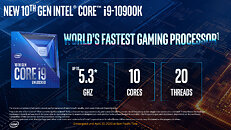
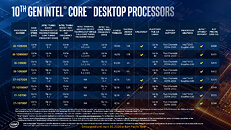
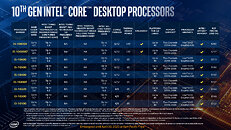
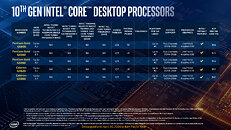



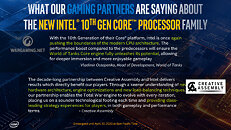



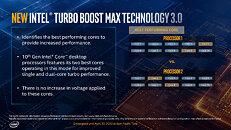
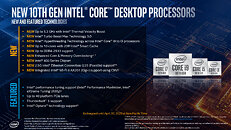
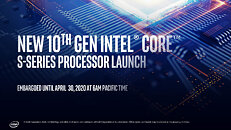
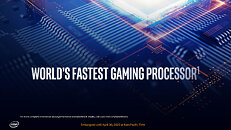

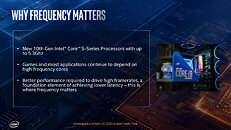








203 Comments on Intel 10th Generation Comet Lake Desktop Processors and 400-Series Chipsets Announced, Here's what's New
I am not quite sure that Windows 10 in its current form supports any single-core processor, to begin with.
You need maximum threads, even threadlets if you will
There are rumours about 15-17% IPC improvement + 200-300 MHz uplift with Zen 3.
True, nobody should be thinking of running a rig based on these parts with a low end PSU, I was thinking of ' older ' systems where the user might upgrade the CPU/MB/RAM and hold the other parts, including the PSU.
But outside of the world of gamers who are pro-ethletes, cores matter. Look at the market, who is buying what with how many cores should tell you what you should know. If people didn't need more cores, they would all be buying 4 core parts, but they are not. And talking about niche world of 1-2% of all users, most people aren't pro-gamers. And if you happen to buy more cores than you need its always nice to have them available, with few penalties, for those times you do need them.
Can't ignore power consumption either, that is why skylake uArch is a huge problem, its not efficient, not at those clocks. When you see the reviews, and the ridiculous heat these things are producing, and the huge power consumption, you will understand.
Where are you getting the 20% less FPS statistics for equivalent parts, you cite a 64 core cpu versus a 8 core cpu, no one, especially an ethlete, is buying HEDT to pro game. AMD isn't 20% less FPS behind with single core IPC on average. The 90% of users statistic dont need more than 4 cores is also questionable, these parts aren't marketed towards average consumers.
2. In its current form Intel CPUs are the fastest in the world in single threaded performance (for running x86-64 code). This has nothing to do with IPC or anything. I don't give a damn about future AMD or anyone's products. And when you're talking about Zen 3, start talking about Ice Lake which has a much higher IPC than Zen 2 and Tiger Lake which adds up to 20% of performance on top of Ice Lake.No, they don't. Absolute most people out there do NOT run on a regular basis:
- Compilation
- Rendering
- Video/audio encoding (hardly any users reencode video)
- Scientific research and computations
- AI
These are all extremely specialized tasks for very few people out there - again, just like I said, 2% of the global population using PCs or less. Also, a lot of tasks don't quite scale well when you're adding MOAR cores, e.g. the x265 code can effectively use only 16 cores and adding more on top improves performance in a less than linear fashion.Why does every discussion about Intel and NVIDIA turn into a cesspool of disinformation, myths and "AMD will work better in the future"? No one cares! People buy products to run them right away.
And speaking of feature completeness.
I've recently bought an AMD Radeon RX 5600 XT video card, based on the SUPER DUPER RDNA 1.0 architecture, which in AMD fans' eyes is the second coming of Christ. What did I get:
- AMD drivers can't control gamma in games which is a must for tons of people
- Fan curve is broken (I'm rocking the latest BIOS and the newest 20.4.2 Adrenaline Drivers)
- Video acceleration consumes more than twice (!) as much power as NVIDIA Pascal on 16nm which was released 4 years ago(!) - 28W vs 12W.
- With the fan stop feature turned on the card runs at staggering 57C (!) while browsing the web while my previous GTX 1060 ran at modest 42C with everything else being equal. As a result my X570 chipset is now running at 65C instead of 58C with an "old" "bad" NVIDIA GPU.
Speaking of the amazing Zen2/X570 combo. In idle it consumes over 25W of power (which is a lot when talking about millions of systems) vs. around 7W for Intel which has a bad "14++++++" node and an even worse 22nm node for its Z390 chipset.Once again, your fanboyism undermines the professional conduct of all the other writers on this site.
Even they know they can't compete with Ryzen, hence the whole recent marking "best gaming cpu", best at "real world performance" etc.
best they have on mainstream platform is 10c/20t cpu, while ryzen is 16c/32t, the 3900X alone makes the 10c/20t Intel already obsolete at anything beyond pure gaming, and on the higher end 3950X and 3960X makes the whole HEDT line pointless even after they did the 50% price cut on the 18c36t.
Lets be real - nobody (as in the "major public", not talking about "PCMR" type of people) should really cares about Intel's 5% to 10% performance "advantage" at 1080p, the reason people "care" about the gaming advantage is their brand perception/ recognition and obviously OEM ties, and if we were to look at laptops for example, the oems are happy with intel's minimal tweaking on the CPU's, as they can rebrand they same laptop internals with "new cpu" and pretty case.
I might be on "Team Red", But in the the end our power as costumers comes to power when we vote with out wallets, I didn't buy the 3900X from the perspective of "AMD Fanboy", but as a costumer who had an Intel Ivy Bridge CPU and were looking for a major update, after having the same CPU for more than 5 years (the last year was on an cheap ebay xeon 1270v2 ~ i7 3770), the same reason In 2012 when looking to upgrade my Aging E8400 C2D, I've decided on the i5 3470 and not the equivalent FX bulldozer (as it was already "crap" then..)
AMD may shot themselves in the leg when they made the Bulldozer and let Intel do nothing for years, but as karma goes, Intel did the same when they stopped "innovate" and got stuck on 2 single products, skylake and the failed 10nm node. good for them that they have enough cash to throw on marketing and OEM designs for years to come (beside many other decent products they have outside of CPU's that make profit).You really can't compare, Active cooling on X570 boards is there because latest trends in case airflow is fans stuck on glass leading to no actual airflow on the chipset from your case, they might as-well put some effort and designed a decent cooling solution (GB X570 Xtreme shows it possible) and making note that you need minimal airflow from your case, but they assume (and rightly I would say) that people would put the boards in those no airflow cases and instead of burning them to death they decided to just deal with the fan and peoples complain.
The Fan on my X570 Master is 99.9% of the time totally off and temps are under control from the case/GPU fans running. Its not perfect but its the price you pay sometimes for being an early adopter. the Chipset itself on Z490 don't support PCI-E 4.0 and will not support it, its the GPU PCI-E x16 stop that is "PCI-E 4.0 Ready", on X570 you already have PCI-E 4.0 (no matter how pointless it is for GPU's and current 4.0 ssd's) for both the chipset (hence the fan) and nVme/GPU slots. and for people complaining on X570 boards pricing, it seems that Z490 is not better.. it seems that beefy VRM (unlike most z370 boards that fire hazzard) and features does cost money..
All in all, it's just another uninteresting generation that I'll skip. I'll see what the next one and Ryzen 4xxx brings. I don't need more than 4 cores for gaming just yet anyway.
Edit: as a sidenote, I'd rather have a reasonable base clock on a reasonable number of cores than a low base clock on a million core chip with mystery turbo version whatever.
I'm sure reviewers will test 10c Comet Lake's extent of reliance on PL2 to even perform as advertised, let alone manual overclocking. One of the things it should reveal is whether Z490 motherboards "effectively require" active VRM cooling.Your quick-to-judge reactions are a thin veil for your own fanboyism. Destructive criticism of my work seldom escapes my banstick; and casting aspersions on my professionalism on the basis of my personal comments (in the comments section), never escapes it. You have been warned.
So here's a little thought starter.
How does the i5-10400 (65W) stack up to the 3600 (65W)?
How about the i5-10500 (65W)?
How does the i5-10600 (65W) stack up to the 3600X (95W)?
These are all 6C/12T CPUs now and will co-exist at comparable price points. My thought is that in the midrange, Intel's new chips are going to clock AMD's 3XXX offerings (pun intended).
No offense, but it's so uncanny, that i have to point it out that you're literally echoing what Intel had been telling us before ryzen: "All you need is four cores, all you need is single thread, etc". It was that hubris and ignorance that dethroned Intel and has them at the point of being a joke to enthusiasts, and you're spewing forth the same exact nonsense... CrazyHave you ever considered that "most people don't need more than four cores", because they didn't have an option to buy more than four cores up until ryzen? Have you ever considered that software is gearemore toward single thread and Intel NOT because it's the best option, but because Intel monopolized the industry for so long? You have individuals in this comments section talking about using a build for 5+ years... Do you really think four cores will be enough in even 2 years? Do you really think with AMD's momentum and stellar multi threaded performance, growing popularity that more and more software, including games, wont start using more threads?
No offense, but it's so uncanny, that i have to point it out that you're literally echoing what Intel had been telling us before ryzen: "All you need is four cores, all you need is single thread, etc". It was that hubris and ignorance that dethroned Intel and has them at the point of being a joke to enthusiasts, and you're spewing forth the same exact nonsense... CrazyHave you ever considered that "most people don't need more than four cores", because they didn't have an option to buy more than four cores up until ryzen? Have you ever considered that software is gearemore toward single thread and Intel NOT because it's the best option, but because Intel monopolized the industry for so long? You have individuals in this comments section talking about using a build for 5+ years... Do you really think four cores will be enough in even 2 years? Do you really think with AMD's momentum and stellar multi threaded performance, growing popularity that more and more software, including games, wont start using more threads?
No offense, but it's so uncanny, that i have to point it out that you're literally echoing what Intel had been telling us before ryzen: "All you need is four cores, all you need is single thread, etc". It was that hubris and ignorance that dethroned Intel and has them at the point of being a joke to enthusiasts, and you're spewing forth the same exact nonsense... CrazyI absolutely guarantee that not your real reason, just your pretext.... and if you'd take an hour to study social identity theory and in/out group psychology as it relates to brand loyalty, you can easily spot the textbook examples of people defending their irrational loyalty to brands with rational arguments, which as I previously stated, is not their true reasoning, only their pretext
-Why do you believe that we need to run a dozen BIOS updates to get a stable AMD CPU environment, there have been only 2 EUFI updates for my x570 system which is 3950X on CH8, and it worked fine and was stable on the one it shipped with.
-A lot of tasks do scale with thread count. Intel is releasing a 10 core part here, not a 4 core part. Also, with only 4 cores, you are limited in the number of single threaded apps you can run simultaneously. This isn't a niche domain. Why would anyone advocate just scaling clocks and power consumption in fewer cores versus spreading loads out over multiple threads, this is how we are getting around physical limitations with our current technology. Intel is marketing these products to people that do run lots of apps, they have the word "megatasking" on the product marketing slides.
-Your personal AMD GPU problems are relevant to comparing an AMD CPU and its core performance to Intel CPUs how? If you want to discuss product problems, AMD hasn't been plagued by the numerous security issues that intel has over the past years, and patches for those have slowed intels IPC advantage.
-Intel has had a monopoly over the CPU market for so long, it is stagnating, releasing iterative products on the same process node, without new features, look at the iGPU in these "new" CPUs. The skylake uArch doesn't suck, its just doesn't exist in a vacuum. Everyone is benefiting from reduced prices and competition, and at the risk of angering you further, more cores.
-Power Consumption, you can't ignore that. The only way to beat AMD IPC is via clock speed at the expense of extreme heat and power consumption.
-Im not claiming that AMD will work better in the future, im claiming it is working better now for all the reasons stated, this isnt a myth or a cesspool of disinformation.no it was anecdotal based on my personal experience